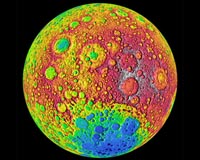 |
Sydney, Australia (SPX) Dec 09, 2010 Getting something onto the surface of the Moon intact is always a challenge. Gravity pulls you in. There's no atmosphere to slow you down. Parachutes don't work. Your only hope is to use thrusters to slow down, and gently touch the surface. This approach has worked fine for soft landers in the past. All you need is a clear, safe place to land. What, then, do you do when the ground beneath you is not so easy to navigate? The LCROSS mission's hard impact into a polar crater on the Moon has yielded a lot of information on the materials to be found there, including large amounts of water. It's also provided an unexpected insight into the physical properties of the region. Scientists had expected a massive flash of light when LCROSS impacted in 2009. Instead, they barely saw anything. This was a disappointment to astronomers, but a useful clue to the surface properties. The ground wasn't as hard as had been expected. It seems that the Centaur rocket stage used to produce the artificial crater sank into softer ground. We still don't have a clear picture of the mechanical properties of the impact site or other regions at the pole. But this unexpected discovery must surely make us wonder. How firm will these areas be for landers and rovers? It's doubtful that anything that touches down there will sink, but we don't know how well the ground would react to a large object. At the very least, conventional rovers could find it difficult to move in some areas. The recent problems of the Spirit Mars rover, bogged beyond recovery in fine Martian soil, could be repeated on the Moon. Landing is even more complex. You will hit the surface of the Moon with some speed, and also risk stirring up the surface with thrusters. Most Moon landers kick up a lot of dust from their engines as they get close to the ground. At the frigid poles, the thrust could also melt some of the permafrost, causing it to sublimate into clouds of vapour, or turn to a short-lived slush. This could spatter the lander with lunar mud, and leave its footpads buried in frozen soil. At the very least, you will profoundly disturb the virgin lunar territory that you are trying to explore. Anything around you could be changed, both physically and chemically. To explore real lunar wilderness, you will need to trek away from the lander with a rover. Let's just hope that the rover can still work! It's time to consider different ways of touching down at the lunar poles. One possibility involves using techniques that have already worked in space. In recent years, the airbag landing technique has delivered three spacecraft to the surface of Mars. The idea is to absorb the force of touchdown in the airbags, and slow down a little more before impact with some rocket thrusters. The thrusters are fired high above the ground, and do not impinge directly on the surface. Imagine doing this on the Moon. A much larger rocket stage could fire at a high altitude, decelerating the lander. This rocket stage could then eject the landing module, which would inflate its airbags and fall. If the ground beneath the lander is soft, this could also cushion the landing. In fact, a variation of this has already been tried long ago at the Moon, although it does not receive as much recognition as it deserves. The Soviet Luna 9 spacecraft was the first object to make a soft landing on the Moon. It used a large rocket stage to decelerate, then ejected an egg-shaped capsule. This capsule apparently used some sort of airbag system for its own landing. After touchdown, the capsule opened up its petals to expose its instruments. The Luna 13 spacecraft later performed a similar landing. Perhaps a simple landing capsule should be targeted for a polar lunar landing, simply to provide proof of the ability to land there, and measure the mechanical properties of the lunar soil. It could also carry a small rover, similar to the Sojourner rover sent to Mars. This would help us to plan more sophisticated landers and rovers. Without a pathfinder mission to the lunar poles, we could be risking a lot on a more expensive mission. Dr Morris Jones is an Australian space analyst and author. Email morrisjonesNOSPAMhotmail.com. Replace NOSPAM with @ to send email.
Share This Article With Planet Earth
Related Links - Mars News and Information at MarsDaily.com Lunar Dreams and more
 New Analysis Explains Formation Of Lunar Farside Bulge
New Analysis Explains Formation Of Lunar Farside BulgeSanta Cruz CA (SPX) Nov 12, 2010 A bulge of elevated topography on the farside of the Moon - known as the lunar farside highlands - has defied explanation for decades. But a new study led by researchers at the University of California, Santa Cruz, shows that the highlands may be the result of tidal forces acting early in the Moon's history when its solid outer crust floated on an ocean of liquid rock. Ian Garrick-Bethell, ... read more |
|
| The content herein, unless otherwise known to be public domain, are Copyright 1995-2010 - SpaceDaily. AFP and UPI Wire Stories are copyright Agence France-Presse and United Press International. ESA Portal Reports are copyright European Space Agency. All NASA sourced material is public domain. Additional copyrights may apply in whole or part to other bona fide parties. Advertising does not imply endorsement,agreement or approval of any opinions, statements or information provided by SpaceDaily on any Web page published or hosted by SpaceDaily. Privacy Statement |